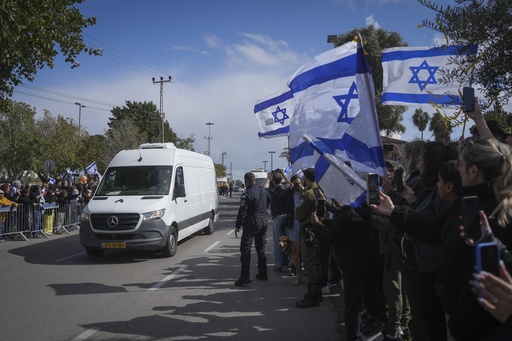JERUSALEM — The tragic fate of Ariel and Kfir Bibas, the youngest hostages taken during the Hamas attack on October 7, 2023, has become emblematic of the horrific toll of this conflict. The return of their bodies on Thursday has extinguished hopes of their survival and dealt a heavy blow to a nation still grappling with the effects of the militants’ onslaught.
Ariel, just four years old, and Kfir, only nine months old at the time of their abduction, were central to the emotional narrative that captivated Israel. The painful news of their death comes alongside a separate revelation that a body previously identified as their mother, Shiri, was not her at all. This has intensified frustration among citizens regarding the government’s inability to secure the safe return of around 250 hostages and may amplify pressure on Prime Minister Benjamin Netanyahu to negotiate an extension of the ceasefire.
Shiri and her children were seized from Kibbutz Nir Oz, a scene that was broadcast globally when she was recorded desperately wrapping her babies in blankets while armed assailants took them away. Their father, Yarden Bibas, was also kidnapped but managed to be released on February 1 as part of the initial phase of a ceasefire agreement, which aims to swap 33 hostages for nearly 2,000 Palestinian prisoners in Israeli jails. During this phase, it has been reported that eight of those hostages are now confirmed dead.
Since his return, Yarden has fervently sought news about his family, who have remained unaccounted for during significant periods of the ongoing conflict. Although Hamas released a video confirming Yarden was alive while in captivity, no updates had emerged concerning Shiri or the children. The militant group asserted that they had perished in an Israeli airstrike in the early days of the war, a claim unverified by Israel, which expressed serious concern for their welfare.
Alongside the Bibas brothers, the remains of Oded Lifshitz, who was 83 at the time of his abduction, were also returned. The Israeli military indicated that the body claimed to be that of Shiri Bibas did not correspond to any identified hostage, adding to the distress of the situation.
On Thursday, a large number of Israelis gathered along the route from southern Israel to the National Forensic Institute in Tel Aviv. They stood in silence, often braving heavy rain while holding flags. As the convoy moved through, many were seen embracing their emotions, shedding tears, and singing the national anthem quietly.
The plight of the Bibas children has resonated deeply within Israeli society, prompting widespread protest and a demand for the release of all hostages. Concern for the boys intensified during a ceasefire agreement in November 2023 that saw many women and children returned and heightened as more hostages were freed in the following weeks.
Kfir Bibas, the youngest hostage, captured the nation’s sympathy with his striking red hair and toothless grin, becoming a shared symbol of innocence amid turmoil. The Bibas family and supporters have adopted the color orange as a representation of their ongoing struggle, marking Kfir’s birthday by releasing balloons in that color while seeking international assistance.
Images of the Bibas family, including their love for comic book characters like Batman, have been widely disseminated, creating a familial bond with the citizens of Israel. As interest in their story grew, the Hostages Families Forum underscored that many hostages still remain in Gaza and urged for the ceasefire to continue, asserting, “There is no more time to waste.”
The uncertainty surrounding the well-being of Shiri and her children has left families and friends in agony. Shiri’s sister, Dana Silberman-Sitton, expressed her own despair, deciding to inform her children in December that their aunt and cousins were likely dead after Hamas claimed they had been killed in airstrikes. “I created a defense mechanism for myself,” she explained, indicating her need to confront the emotional turmoil.
Conversely, Yarden Bibas’ sister, Ofri, maintained hope, asserting that Shiri and the boys were still alive. She actively worked to keep their story in the public consciousness, participating in various media engagements.
The heartbreaking narrative of the Bibas family has not only captivated Israel but also drawn global attention, reflecting the most harrowing realities of Hamas’ brutal attack. Ruth Pat-Horenczyk, a social work professor, noted how the haunting footage of Shiri attempting to shield her children has become ingrained in the national psyche. “It symbolizes the pain and tragedy that defines Oct. 7,” she remarked, highlighting the broader implications of their story amidst the conflict.




